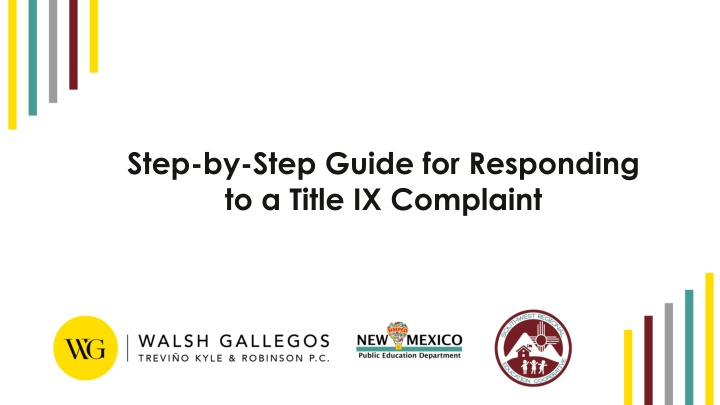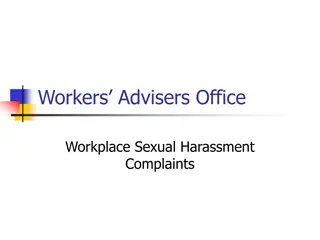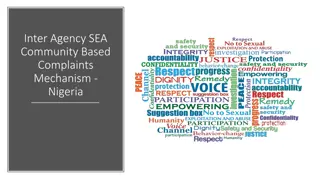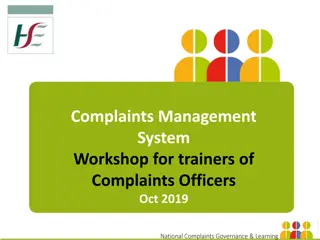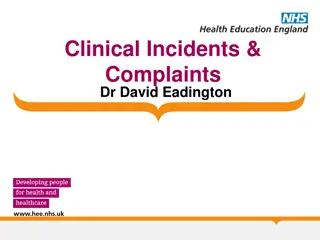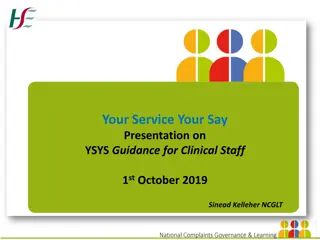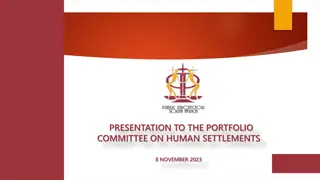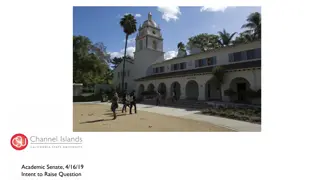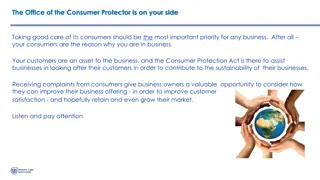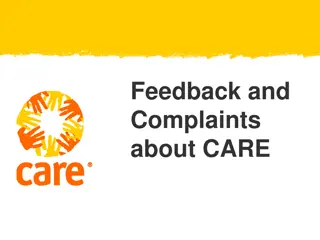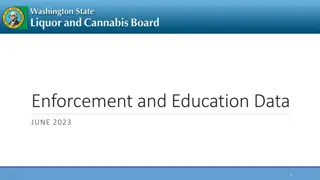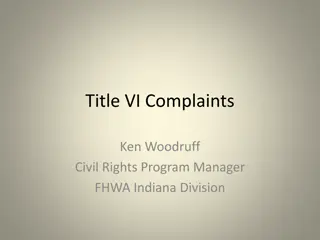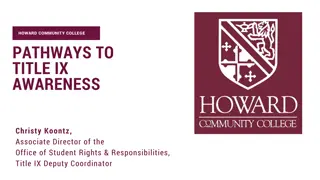Step-by-Step Guide for Responding to Title IX Complaints
Understanding the difference between a report and a formal complaint, responding to reports of sexual harassment, providing supportive measures, determining if it constitutes sexual harassment, and deciding whether to dismiss or proceed with a formal complaint are crucial steps in effectively addressing Title IX complaints.
Download Presentation

Please find below an Image/Link to download the presentation.
The content on the website is provided AS IS for your information and personal use only. It may not be sold, licensed, or shared on other websites without obtaining consent from the author.If you encounter any issues during the download, it is possible that the publisher has removed the file from their server.
You are allowed to download the files provided on this website for personal or commercial use, subject to the condition that they are used lawfully. All files are the property of their respective owners.
The content on the website is provided AS IS for your information and personal use only. It may not be sold, licensed, or shared on other websites without obtaining consent from the author.
E N D
Presentation Transcript
Step-by-Step Guide for Responding to a Title IX Complaint
Report versus Formal Complaint The regulations distinguish a report from a formal complaint. A report is simply the initial complaint, the allegations, which can be filed by anyone. A formal complaint is a printed document or electronic submission filed by a Complainant (in person, by email, by mail or other method provided by District) that alleges sexual harassment and requests a school/district investigation of the allegation. 2
Responding to the Report The report of sexual harassment may be verbal or in writing by the reporting party; a receiving administrator should document a verbal report. The written report must go to the District s Title IX Coordinator (or the Campus Title IX Coordinator, if there is one). Title IX Coordinator must promptly contact the Complainant, and if under 18, their parent/guardian to: Discuss the Report; Explain the Formal Complaint Process and provide the Complainant with a copy of the District s Title IX Formal Complaint Process; Provide information about and availability of supportive measures; and Consider the Complainant s wishes concerning supportive measures and whether to make a Formal Complaint. 3
Supportive Measures Supportive Measures are non-punitive, non-disciplinary services that are offered, as available and without a fee, to both the Complainant and the Respondent. Supportive Measures are available with or without the Report being elevated to the level of a Formal Complaint. Supportive Measures should be documented, kept confidential, and may be changed as the situation warrants or as the Complainant and Respondent request. Can include: emergency emergency removal of a student per the regulations Administrative leave with pay for an employee 4
Is It Sexual Harassment? Title IX Coordinator must determine if what is alleged constitutes sexual harassment as defined by that law. Is an employee of the District conditioning the provision of an aid, benefit, or service of the District or school on a student or employee s participation in unwelcome sexual conduct (Quid pro quo); Is the alleged conduct based on sex so severe, persistent, pervasive AND objectively offensive that it denies the Complainant access to the educational program or activities; or Does the behavior rise to the level of sexual assault, dating violence, domestic violence or stalking as defined in the Definitions section? 5
Dismiss or Formal Complaint? If the conduct does not claim will normally be dismissed. does not meet the definition of sexual harassment, the The conduct can then be investigated and addressed under other policies and regulations. BUT, the Complainant can also still make a Formal Complaint, which may be dismissed by the Investigator. does meet the definition of sexual harassment, the claim must be discussed with the Complainant. If the conduct does Complainant decides whether to elevate the report to a Formal Complaint (or not). Title IX Coordinator can also elevate the allegations to a Formal Complaint if it would be necessary to do so to ensure the District/School is not deliberately indifferent. 6
Other Reasons for Dismissal Mandatory Dismissal: When the conduct does not meet the regulatory definition of sexual harassment. When the allegations did not occur against a person in the United States; or When the allegations did not occur in the District s education program or activity. Discretionary Dismissal: If a Complainant notifies the Title IX Coordinator in writing that s/he would like to withdraw the Formal Complaint or any allegations in the complaint; If the Respondent is no longer enrolled in or employed by the District; If circumstances prevent the District from gathering evidence sufficient to reach a determination as to the formal complaint or allegations; or If the Complainant no longer has any involvement with the District. 7
Employees: Title IX or Title VII Title IX says that no person, on the basis of sex, shall be excluded from participation in, denied the benefits of, or be subjected to discrimination by the district. Title VII says it is an unlawful employment practice for a district to discriminate against any individual with respect to compensation, terms, conditions, or privileges of employment, because of that individual s sex. These two laws prohibit sex discrimination, but define sexual harassment differently. Title VII s definition is broader. So, if the alleged conduct between two employees does not rise to the level of sexual harassment under Title IX, or the employee does not want to make a formal complaint, it can be investigated and addressed under Title VII, as set out in policy. 9
Regulations Set Out Benchmarks for Responding to Formal Complaint of Sexual Harassment Equal Access/Treatment 1. Objective Evaluation of all Relevant Evidence 2. Impartiality - Bias Free 3. Presumption of Innocence 4. Reasonable Time Frames 5. Description of Possible Outcomes 6. Use Designated Standard of Evidence Preponderance of Evidence or Clear and Convincing? 7. Supportive Measures 8. Protection of Privilege 9. 10. Appeal Process Available 10
1. Provide Written Notice of Formal Complaint Upon receiving a Formal Complaint, Title IX Coordinator must provide written notice to the known parties which includes: Description of the process, including informal resolution process Allegations involved must supplement the notice each time new allegations are opened for investigation. Statement of presumed innocence of the respondent The parties right to an advisor of their choice (who may be an attorney) Parties right to inspect evidence relevant to the allegations Notice any provision in the code of conduct that prohibits knowingly making false statements or providing false information. 11
2. Investigate Formal Complaint Investigator must: Identify the allegations under investigation and gather relevant evidence. Provide parties with equal opportunity to have others present during any complaint proceeding. Provide to any involved party advance written notice of all interviews, meetings or other proceedings, with sufficient time for the party to prepare. 12
2. Investigate Formal Complaint Investigator must also: Provide equal opportunity to both parties to inspect and review evidence obtained as part of the investigation (including evidence which the institution does not intend to rely on), and send to each party the evidence at least 10 days before completion of the investigative report. Create an investigative report summarizing relevant evidence. Then send a copy of the report to each party 10 days prior to the time of determination to permit them an opportunity to send a written response. 13
2. Investigate Formal Complaint Finally, Investigator must: Provide the final investigation report and evidence to Title IX Coordinator to provide to Decision-Maker. Remember, the Decision-Maker in a Title IX proceeding cannot be the Title IX Coordinator or the Investigator of the allegations. 14
3. Written Questions from Decision-Maker The Decision-Maker must: Provide each party the opportunity to submit written questions to be asked of another party or witness; Provide each party with the answers to those questions; Provide for limited written follow-up questions. Irrelevant questions can be rejected, but that rejection must be explained. 15
About the Rape Shield Provision Questions and evidence about a Complainant s sexual predisposition or behavior are categorically not relevant to a Title IX Investigation, unless Evidence is offered to prove someone other than the Respondent committed the alleged conduct Evidence concerns the Complainant s prior sexual history with the Respondent and is offered to prove consent. unless: 16
NOTE: What About Live Hearings? In the decision-making process, postsecondary institutions are required to hold live hearings in which the parties and their representatives are present, and ask question one another. But for K-12 settings, live hearings are optional. The process here is based on no live hearing being held. 17
4. Determination of Responsibility The decision-maker must issue a written determination of responsibility that contains: Findings of fact; Conclusions about whether the alleged misconduct occurred; Explanations of each conclusion; and Any disciplinary sanctions or remedies being enacted Written copy of determination must be sent simultaneously to the parties, and it must include information about filing an appeal. Title IX disciplinary action or remedies cannot be implemented until: 1) the deadline for an appeal passes; or 2) the District provides both parties with the written result of any appeal. 18
5. Appeal Written notice must be given to both of the opportunity to appeal a determination of responsibility, but only based on: Procedural irregularity that affected the outcome of the matter; 1. 2. Newly discovered evidence that could affect the outcome of the matter; and/or 3. An employee involved in the investigation process had a conflict of interest or bias that affected the outcome of the matter. A school may offer additional bases for appeal (in policy), as long as the appeal opportunity is offered equally to both parties. An appeal must be heard by a new new decision-maker. 19
5. Notice of Appeal If an appeal is filed, the District must: Notify the other party that an appeal was filed; Implement the same appeal procedures for both parties; Ensure the Decision Maker for the appeal is not the same person as the original Decision Maker, the Title IX Coordinator or the Investigator. Allow both parties to submit written statements in support of or opposition to the Determination. 20
6. Decision-Maker for an Appeal School/District must ensure that the decision maker in an appeal is not the Title IX Coordinator, the Investigator, or initial Decision Maker; AND The Decision Maker for an appeal cannot have a conflict of interest or bias against Complainants or Respondents generally or against the involved Complainant or Respondent specifically; AND The Decision Maker in an appeal must have received the Title IX training set out in the regulations. In the K-12 context, it is customary for boards of education to decide grievance appeals under local policies and procedures. So Districts and their attorneys will need to determine whether it is feasible, given the unique training requirements and prohibition on conflicts of interest above, for a school board to serve in this capacity for purposes of Title IX. 21
7. Written Decision in an Appeal For all appeals, the decision-maker can reach a decision based on the investigation evidence and any appeal documentation. Written notice must be provided to both parties of the appeal and both must be provided an equal opportunity to submit a written statement in support of, or challenging, the determination. The appeal process must result in a written decision that must be provided to both parties simultaneously. 22
Informal Resolution Informal resolution of allegations of sexual harassment by an employee against a student can never be offered. Informal resolution cannot be offered until a formal complaint is filed. Once a formal complaint has been filed, informal resolution options, like mediation, can be offered and provided as long as both parties give voluntary, informed, written consent. Cannot require a party waive their right to investigation or to participate in informal resolution as a condition of enrollment or employment. Any party may withdraw from the informal resolution process and resume the formal complaint process at any point before an agreement is reached. 23
Retaliation Retaliation is prohibited against any individual if it would interfere with their Title IX rights or because an individual has made a complaint or has been involved with a Title IX investigation. Improper conduct by a student or employee that is directed toward any person who makes a good faith report of sexual harassment, or who participates in a related investigation is prohibited. Examples of retaliation could include threats, intimidation, rumor spreading, assault, coercion, destruction of property, name- calling, ostracism, or unwarranted punishments. Conduct that would reasonably discourage a person from making a report of sexual harassment, or participating in an investigation, is also unacceptable retaliation. Charging an individual with a code of conduct violation for making a materially false statement in bad faith during a Title IX complaint proceeding does not constitute retaliation. 24
Overview and Tips for Addressing Title IX Sexual Harassment Reports
Investigation vs. Investigation Report Investigation: Initial fact finding Report Investigation: Initial fact finding A preliminary process to identify who made the Report, determine the contents of the report, and whether the alleged conduct could constitute sexual harassment as defined by Title IX. Could be conducted by a campus administrator. Will determine how to respond to the Report. Formal Complaint Investigation: Title IX investigation process Formal Complaint Investigation: Title IX investigation process An investigation that follows the filing of a Formal Complaint The following slides will focus on the how-to of conducting a formal Title IX investigation following a Formal Complaint. 26
Key Investigation Steps Once there is a Formal Complaint, determine who will investigate Review board policies related to the alleged conduct Title IX, Discrimination, Harassment, Retaliation Student Code of Conduct Employment policies/employee handbook/CBA Consider whether interim actions are necessary to protect any person or to preserve the integrity of the investigation. Such actions likely would have been taken by Title IX Coordinator following receipt of initial Report. While no discipline can occur, an accused employee can be placed on administrative leave with pay, and a student s emergency removal may be warranted. 27
Key Investigation Steps Interview the Complainant first, if possible Get a clear understanding of what is being alleged, including who, who, what, what, where, where, when, when, why why. Serves as road map for rest of investigation Interview the person who made the report, if different than Complainant. Interview witnesses Interview the Respondent 28
Key Investigation Steps Obtain written, signed and dated statements from each person interviewed. Gather any relevant documentation or evidence: Emails, texts, or other correspondence or notes Surveillance video, cell phone video, photos Electronic messages, posts to social media Prepare investigation report that will be provided to parties. Report to law enforcement, CYFD, PED, etc., if required. 29
Documentation Tips Notes should be thorough and detailed Include date, start/end times, location and names of people present Use exact quotes where possible Label rumors as rumors Avoid opinions of interviewer Recap notes with witness to confirm understanding Obtain a signature of any statement made by witness 30
Interview Tips To Record or Not? To Record or Not? Probably NOT required to record but check your local policy and know local practices. But no secret recordings! Keep recorder in plain view and advise the witness you are recording. State the date, time, location and identify individuals present. Label and secure the recording. 31
Interview Tips Be professional. Address concerns or reluctance of interviewee. Ask open-ended questions in a non-judgmental way. Ask witness to be clear about what is rumor or speculation and what was seen/heard. Ask witness to identify other witnesses. Discuss concerns about on-going interaction with the Respondent, if any. Encourage complainant to provide additional information as it becomes available. Obtain a written statement. Have another administrator or employee present to witness the interview where possible, especially in regard to Complainant and Respondent. 32
Interview Tips Obtain copies of any documents identified or referenced by witness. Make no promises regarding confidentiality or the outcome of investigation. Interview all witnesses separately. Explain the process and reason for meeting. Be factual, avoid any implication that Respondent is guilty or innocent, or that a decision has already been made. Ensure witness knows s/he has right to be free from retaliation. Don t identify other witnesses/discuss the merits of the complaint. 33
Interviewing the Respondent Generally, interview the Respondent last, after interviewing the Complainant, the reporting individual, and any witnesses named by the Complainant. Make a checklist of the specific allegations to cover in the interview with the Respondent. If the allegations are of a criminal nature and the accused refuses or has been advised not to respond, document efforts to interview the Respondent. Interview any witnesses named by Respondent. 34
Record Keeping - Seven Year Retention for: Records of: each sexual harassment investigation of a Formal Complaint, to include any documented dismissal and the reasons for same; 1. any appeal; 2. any informal resolution; and 3. training materials. 4. Also, retention and publication of training materials: Retain any materials used for training Title IX Coordinator, investigators, decision makers, and any other person who facilitates an informal resolution process. These materials must be publicly available on the district s website. 36
More on Record-Keeping Documents from the Formal Complaint include: The Determination; Any Disciplinary Sanctions issued; Remedies provided to the Complainant; Any appeal; and Any Supportive Measures implemented or offered, if none were provided, the reasons why. 37
A Word About Policy If it is not up-to-date, it will be essential to update district policies and procedures to reflect the new Title IX regulation requirements. Remember, this will include both student policies and employee policies. NOTE: For employees, the protections provided by Title IX are more limited, but they are in addition to the broader protections for employees under Title VII. 38
